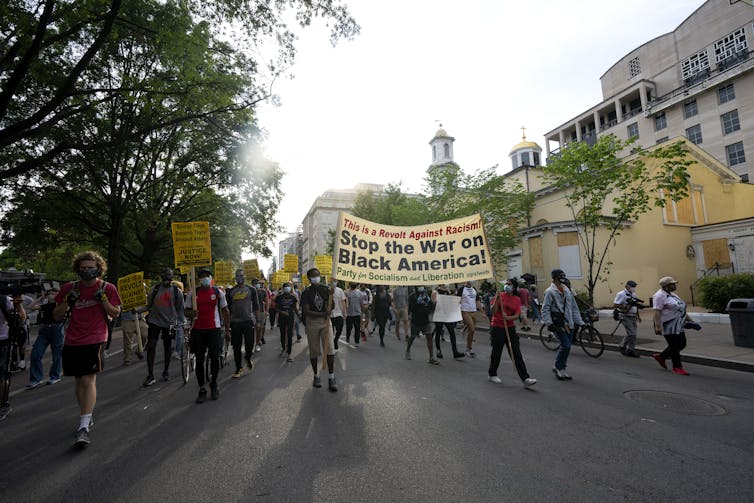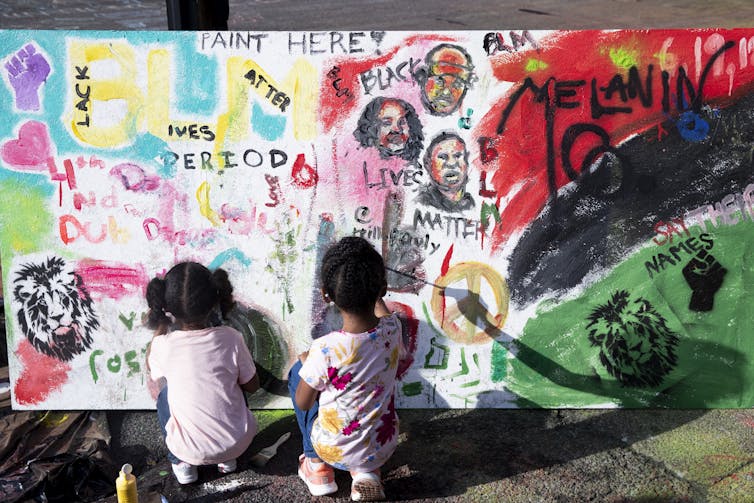Is America a 'failing state'? How a superpower has been brought to the brink
- Written by George Rennie, Lecturer in Politics, University of Melbourne
After the collapse of the Soviet Union, there was a sense history had ended, and that the United States represented a supreme endpoint.
Today, the US is not dominant, it is in crisis: convulsed by riots and protest, riven by a virus that has galloped away from those charged with overseeing it, and heading into a presidential election led by a man that has possibly divided the nation like no other before him.
Using the most common metrics available to political scientists, there are signs the United States is failing.
Until very recently, this idea was extraordinary, unthinkable to all but the most radical critics. But, the US is increasingly performing poorly on key predictors of state failure: ethnic and class conflict, democratic and institutional backsliding, and other socioeconomic indicators including healthcare and inequality.
Read more: When Trump attacks the press, he attacks the American people and their Constitution
Ethnic and class conflict
Comparative politics pays great attention to the role of ethnic conflict as a predictor of state failure. Those who study African countries, where most of the flare-ups are currently taking place, often observe that ethnic conflicts are closely correlated with battles to secure key resources, such as water and arable land. This closely relates the study of so-called “grievance studies”, which typically regards deep-seated inequalities as causing resource conflicts.
 Black Lives Matters protesters in Washington D.C.
AAP/Sipa USA/CNP
Black Lives Matters protesters in Washington D.C.
AAP/Sipa USA/CNP
However, it would be a mistake to think this is because of different ethnic groups per se. It is more to do with how inequality and poverty exacerbate perceived racial and cultural fissures. The US reflects this problem, where the experience of many black Americans is telling: they feel “criminalised at birth”, and when this perception reaches a critical mass among a large enough population, states fail.
The global conflict zones that political scientists largely focus on are where groups are fighting for basic resources. These include water, mineral, and other basic economic rights.
So, areas that are deeply impoverished, such as Flint, Michigan, or almost any other recent area of profound socio-economic distress, are highly analogous to failed countries. They have also been some of the biggest challenges to the “united” part of the United States.
Signs of increased economic inequality
Yet, the economic indicators are not only dire for minority groups. America’s economy has grown at a good clip for decades, but the wealth has been taken up almost entirely by the wealthiest. For example, CEOs’ pay went from 20 times the average workers’ salary in 1965 to 278 times their salary in 2018.
In real terms, only college graduates have seen their pay increase as a group since 1979, and this occurs while 21% of American children live in poverty. Moreover, health outcomes for Americans are very poor compared to other OECD countries, despite having the highest per capita healthcare costs in the world.
Disproportionately, this is a problem affecting black Americans. This might go some way to explaining recent riots, but is far from a complete picture. All poor Americans are getting relatively poorer, which may also explain why poor white Americans seem increasingly likely to fight against the perceived injustices of other ethnic groups. They do this by pitting themselves against similarly politically and economically disenfranchised groups, rather than the power system that keeps them dispossessed.
 Two children paint a mural at Black Lives Plaza, Washington D.C.
AAP/EPA/Michael Reynolds
Two children paint a mural at Black Lives Plaza, Washington D.C.
AAP/EPA/Michael Reynolds
Adding to this, a major historical study by Thomas Piketty showed the disconnect between the poorest and wealthiest Americans is getting exponentially worse, the middle class is shrinking, and the wealth of the top 1% is taking up an increasing share of the pie.
Is there a democratic deficit?
This wealth disconnect is increasingly represented as a deficit in democracy. As one study showed, America’s democracy is being seriously undermined.
In fact, “undermined” is putting it mildly: after a rigorous analysis of voting from 1982 to 2002, Gilens and Page showed the preferences of the top 10% routinely trumped those of average voters.
It would be a mistake to underestimate the importance of these findings. As analyses of the 2016 general election showed, the US states that flipped from Democrat to Republican (supposedly part of Hillary Clinton’s “firewall”) were almost exclusively part of the so called “rust belt”. Once part of America’s all-powerful manufacturing base, they are now people who feel forgotten, and increasingly angry.
The black and white, racial narrative of America’s woes misses an important, but even more consequential point: while there is no doubt black Americans are disproportionately suffering, an increasing majority is losing out, regardless of race.
American hope
The American revolution centred on the very sensible idea there should be no taxation without representation. Yet, there is now significant evidence that a majority of citizens are not being represented.
The US has one advantage: for all of its flaws, it remains an at least semi-functional democracy. This may well mean blame for state failure can exist with individuals or parties, rather than the entire system.
However, the democratic institutions of the United States continue to break down, and successive governments have proved unable to respond and listen to their citizens. Bizarrely, by the most important indicators available to political scientists, the United States is failing.
Even among its most ardent critics, few would consider America’s failure to be anything other than a catastrophe. The domestic deterioration of the world’s biggest nuclear and military superpower would prove unprecedented and frightening beyond rational analysis — rhetoric suggesting this is merely the new “fall of Rome” is almost glib.
The challenge now is whether the world’s oldest continuous democracy can live up to its own ideals.

